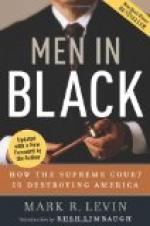The white marble palaces of the higher courts wherein broad stairways, paneled mahogany, stained glass, and soft noiseless carpets giving an air of repose and refined culture, are not altogether consistent with the modern spirit. The man on the street does not understand whether the marble statues on the roof are symbols of justice or late presidents of the United States. The usual courthouse of twenty years ago was a mixture of armory and Gothic church.
In the larger courthouses where there are many terms or parts in one building, there is an air of confusion. Rotundas, corridors, stairways, and elevators are constantly filled with a moving crowd of lawyers waiting for their cases to be tried, clients who have had appointments, witnesses who have been subpoenaed to come to court and when they get there find it is not one court, but thirty. The latter are found wandering dazedly about asking anyone who will stop to listen if they know in which part the case of Martin vs. Martin is being tried. Lunch counters, telephone booths, and a feeling of awe are in the building.
What that terror of a court of law comes from is difficult to analyze. There is the impressive majesty of the law; always about a court is the inspiring sense of something more than human. Even an empty court-room is not as other rooms. Like an empty theater there remains an atmosphere of glamour, of mystery, and yet equally true there remains a substantial, strong odor of crowds.
It is said that every theater retains its own peculiar smell. The scientific investigation of the psychology of odors is too subtle to be understandable. The question of analyzing the exudations of a nervous crowd seems interesting, but the remembrance of an anxious humanity is always present. In former times the attendant placed a small bunch of herbs and aromatic flowers on the judge’s desk, and glasses of the dried bouquets remained in a row for long periods.
Hygienically considered the courts are unsanitary. If the windows are opened the cold air is apt to draw directly on the heads of the jury and the stenographer. In summer the noise of city streets, the cars, the elevated, the cries of children, the hand-organs, the flies, are not at all conformable to the supposed dignity of the court. It is well-known that the crowded and unhealthy conditions of the courts are conducive to disease as well as discomfort to the inhabitants.
The connotations of the name court are generally impressive. There is the suggestion of jail, of punishment, of something final, of absolute judgment. Also it suggests the courtyard of a tenement house, an alleyway or something shut in and confined. The philology is from the old French cort or curt. It is curious that it means something narrow. There are the suggestions of the lists, of heralds, of trumpets, of banners and knights in armor, of prancing steeds, of fair ladies watching, of joust, tournaments, and




